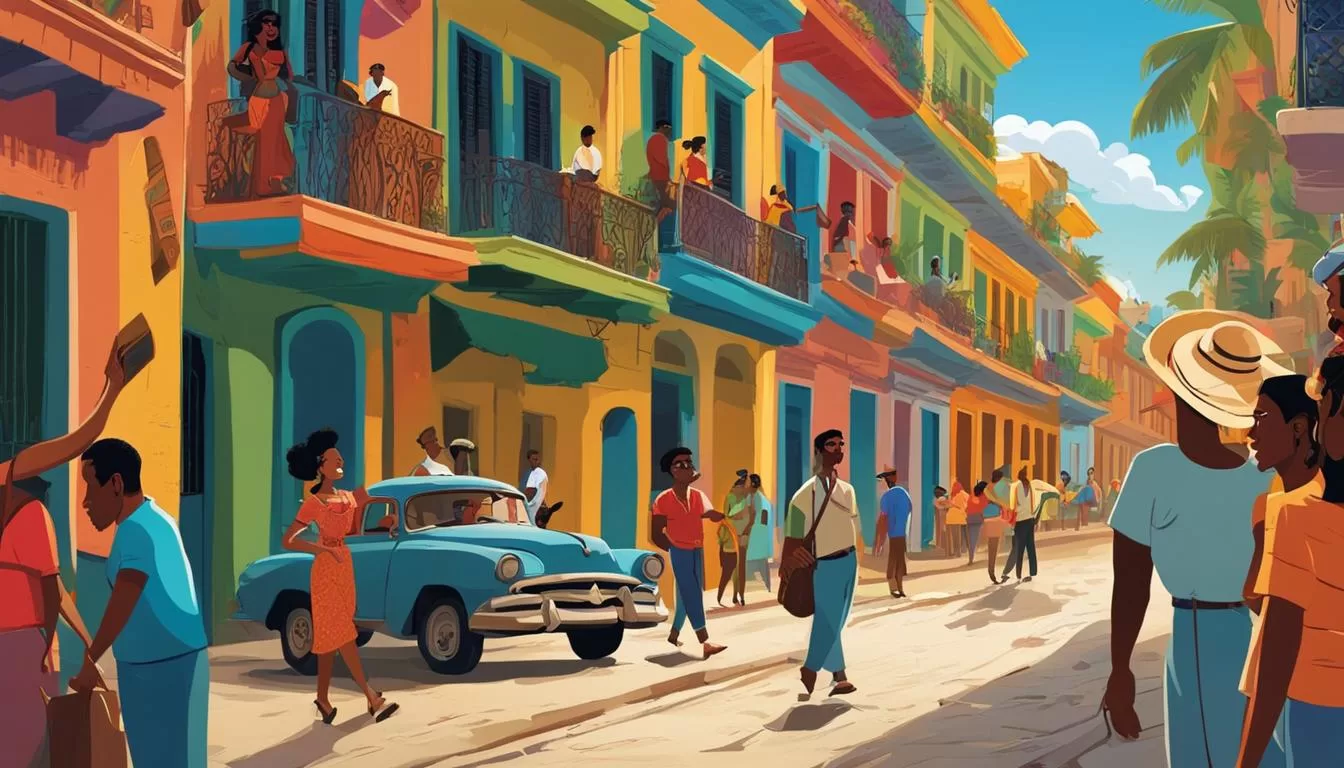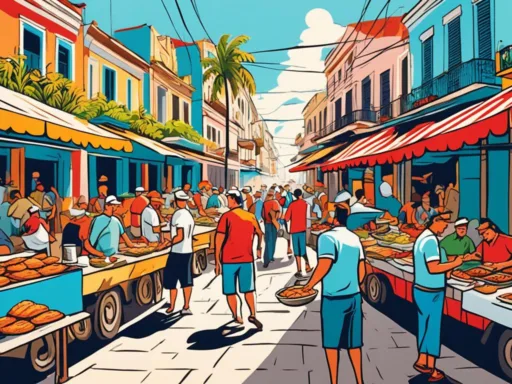The mosaic of languages spoken in Cuba tells the story of the island’s vibrant history and cultural diversity. At the heart of this linguistic tapestry lies Spanish, the official language of Cuba, with its unique Caribbean nuances that resonate through the bustling streets of Havana to the serene landscapes of the Viñales Valley. But the country’s language is not monolithic; it is shared with a plethora of other Cuban languages that encompass the traditions and histories of its people.
Through continuous waves of immigration and the enduring legacy of its indigenous populations, Cuba has cultivated a rich lexicon that goes beyond its official tongue. From the rhythmic beats of Haitian Creole in the east to the echoes of Galician and Corsican from European settlers, Cuba’s linguistic landscape is as varied as its music and art. It is a culture where language acts as a bridge, connecting the past with the present, and the island with the broader world.
Key Takeaways
- Spanish is the primary and official language of Cuba, reflecting the island’s colonial heritage.
- Cuban Spanish is a distinctive form of Caribbean Spanish, shaped by its indigenous and unique expressions.
- Haitian Creole stands as the second most spoken language in Cuba, highlighting the island’s diverse ethnic fabric.
- Lucumí, Galician, and Corsican add to the polyglot nature of Cuban culture, each with its own historical significance.
- The linguistic diversity of Cuba mirrors its complex social and historical narratives, offering a window into the nation’s soul.
Official Language and Cuban Dialects
When walking along the colorful streets of Old Havana or traversing the lush landscapes of the Cuban countryside, one is immediately enveloped by the rich tapestry of sounds that Spanish in Cuba weaves. The distinctive linguistic character of Cuban dialects is not just a variant of Spanish; it is a reflection of the island’s complex history and cultural synthesis. From everyday conversations to literature and music, the nuances of Cuban Spanish serve as a testament to the island’s multifarious identity.
Richness of Cuban Spanish
Cuban Spanish, the official tongue of the nation, pulsates with a vibrancy unique to the Caribbean. Infused with indigenous phrasings and further enriched by waves of immigrants, it has evolved into a dialect marked by its lively intonation and distinctive vocabulary. Indigenous languages of Cuba, like those of the Taíno, left an indelible mark; and over time, the Spanish spoken on the island has wrapped these threads into its very fabric, creating an intricate linguistic quilt.
Influence of Taíno Language
Apart from its Spanish foundations, Cuba’s linguistic heritage received substantial contributions from the Taíno people. The remnants of this extinct indigenous language peek through in everyday language, leaving behind not just words, but a portal to a distant past. Cuban Spanish carries the legacy of the Taíno, with a selection of nouns that have become integral to both the lexicon and the culture.
Unique Cuban Slang and Expressions
Furthermore, the particular Cuban flair can be seen in an array of expressions peculiar to the island. Adopting alternative terms such as “Fruta bomba” in lieu of “papaya,” residents navigate an intricate system of vernacular peculiarities. This vibrant slang, or cubanismos, turns the act of communication into a cultural immersion, offering both challenges and delights to linguists and laypersons alike.
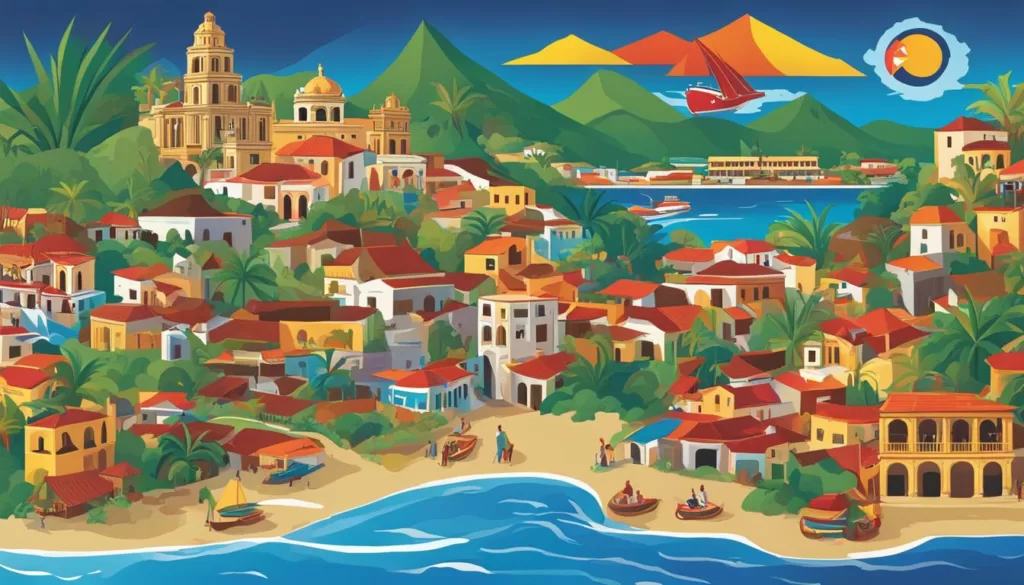
“To speak Cuban Spanish is to speak with the island’s rhythm, to tell its stories, and to embrace its history.”
The tapestry of Cuban speech is an embodiment of its people’s spirit, a spectrum of linguistic diversity that spans from the everyday slang on the streets to the sacred chants of Santería rituals. It is a language alive with the memories of its ancestors and the dynamism of its present, a true reflection of Cuba’s vibrant heart.
- Cuban Spanish: The official language, characterized by its unique pronunciations and terms.
- Taíno Influence: Legacy words such as “hamaca” and “tabaco,” found in everyday Cuban Spanish.
- Cuban Slang: Expressions and terms that resonate solely within the island’s borders.
A Glimpse into Indigenous Languages of Cuba
Long before the rhythmic Spanish tongue became synonymous with Cuban culture, the island resonated with the words of the indigenous languages of Cuba. Among these was the language of the Taíno people, whose influence has permeated the contemporary Cuban Spanish dialect. Although the Taíno culture experienced an unfortunate decline, their linguistic contributions continue to echo throughout Cuba’s valleys and cities. The Taíno language influence is an integral thread in the rich tapestry of Cuban history and identity.
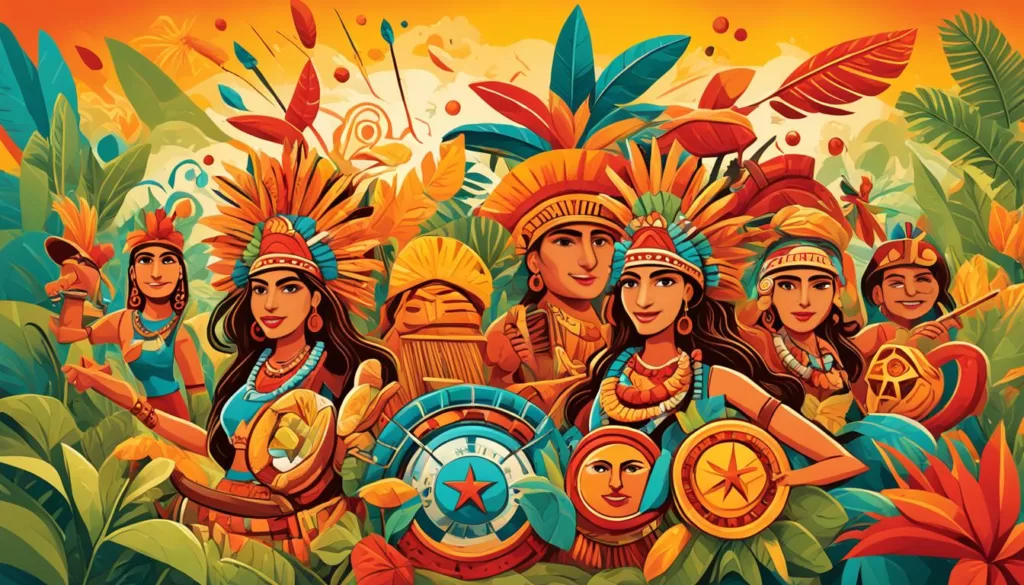
The surviving Taíno vocabularies are like historical artifacts, embedded within the fabric of daily Cuban speech. The words passed down through generations serve not only as linguistic remnants but also as cultural signifiers that define a set of shared experiences and an identity that is undeniably Cuban. To this day, these words offer a portal to understanding the lifestyle and environment of the island’s original inhabitants.
Here are some examples of Taíno contributions to modern Cuban vocabulary:
| Spanish (Cuban Use) | Taíno Origin | Meaning in English |
|---|---|---|
| barbacoa | barbacoa | barbecue |
| canoas | canoa | canoes |
| hamaca | hamaka | hammock |
| tabaco | tabako | tobacco |
These words are far more than mere symbols; they are the survivors of a lost language that once flourished across the Caribbean islands.
As the winds of change swept over Cuba, the Taíno were eclipsed by the advent of Spanish colonial forces. However, their language refused to be silenced, stubbornly persisting within the spoken word of Cubans today.
The lasting effects of the Taíno legacy within Cuban linguistics prove that a language, even if not spoken in its original form, can transcend time, influencing future generations in unexpected ways. It underlines how indigenous roots form an undying foundation for the current vernacular, shaping the narrative of the nation’s history for both residents and curious linguists alike.
- The survival of Taíno words in Cuban Spanish serves as a testament to the persistence of culture through language.
- Integrated into everyday conversations, these words are a part of the living history that is spoken by millions throughout Cuba.
The magnificence of the Taíno influence is a reminder of the richness of Cuba’s indigenous heritage, playing a significant role in the evolution of the Cuban lexicon and continuing to impact the vibrant cultural landscape that characterizes modern Cuba.
Languages Spoken in Cuba: A Melting Pot of Cultures
Cuba’s linguistic heritage is as rich and varied as its cultural tapestry. The harmonious blending of dialects and languages within the island not only mirrors its historical saga of migrations and interactions but also paints a vibrant picture of its present-day community. From the resonant tones of African languages to the subtle cadences of European dialects, Cuba’s linguistics landscape is a testament to its complex past and dynamic cultural exchanges. This section delves into the diverse languages that contribute to Cuba’s distinctive voice, adding layers of depth to the island’s identity.
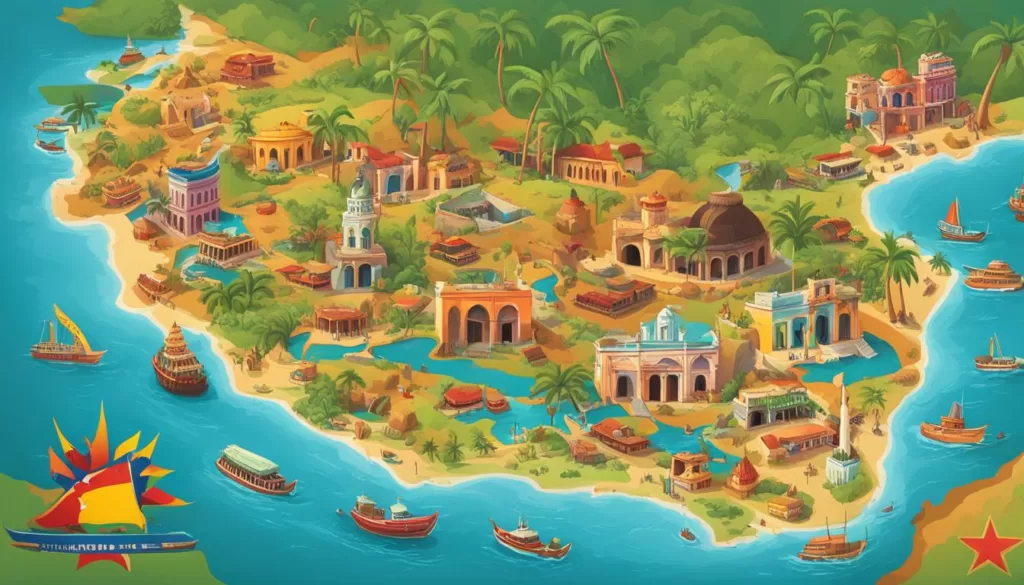
The Presence of Haitian Creole
The echo of Haitian Creole in Cuba is a reflection of the enduring Haitian influence within the island. Stemming from a history of migration and cultural interchange, Haitian Creole is not only widely spoken but is also cherished as a connection to Cuban heritage. Serving as the second most-spoken language in Cuba, it reflects the strong bonds between the Haitian immigrant community and the Cuban society, preserving the linguistic heritage of generations and enriching the cultural fabric of the nation.
Impact of African Languages
Similarly, African languages in Cuba have played a pivotal role in shaping the island’s linguistic and cultural identity. African slaves historically brought with them a multitude of dialects and tongues that have since woven their way into Cuban vernacular. Notable is the profound impact of African lexicon and phonetics in the ritualistic language of Lucumí, used predominantly in Santería ceremonies. These linguistic elements infuse Cuban Spanish with a rhythm and vitality unique to the Caribbean experience.
European Languages Within Cuba
Further illustrating the island’s linguistic diversity are the remnants of various European languages in Cuba. Migrants from regions such as Galicia and Corsica have left an indelible mark, contributing to the medley of languages heard throughout the island. This mosaic of European influence underscores the complex patterns of migration and settlement that have defined Cuba’s history, adding to the narrative of cultural exchanges that shaped the nation’s identity.
| Language | Origin | Presence in Cuba |
|---|---|---|
| Haitian Creole | Haiti | Widely spoken by Haitian immigrants and their descendants |
| Lucumí | West Africa (Yoruba) | Used in religious contexts, particularly in Santería rituals |
| Galician | Spain (Galicia) | Spoken by Galician immigrants and their communities |
| Corsican | Corsica (France) | Present among Corsican settler descendants |
Cuba’s vibrant language scene is a clear mirror reflecting its populace’s diverse genetic makeup and the historical epochs that the island has traversed. In every conversation, whether in the lilting melody of Haitian Creole or the robust charm of European accents, the island’s story is told afresh, affirming its place as a melting pot of cultures and tongues.
The Influence of Foreign Languages in Modern Cuba
In the vibrant streets of Cuba, amidst the rich sounds of salsa and the aroma of tostón, the linguistic landscape is becoming increasingly diverse. This multilingualism is most evident in sectors like tourism, where the necessity to communicate with visitors has brought foreign languages to the forefront of Cuban society. The prevalence of English in Cuba is notable, as it has become a bridge between Cubans and the English-speaking travelers who explore the island’s charms.
But English is not the only foreign tongue to be heard in the Cuban archipelago. French in Cuba echoes in the colonial alleys of Old Havana, spoken by those who cater to visitors from la Francophonie. Similarly, the influx of tourists from Eurasia has fostered a need for Russian in Cuba, with phrases of greeting and commerce spoken in a Slavic twist among Cuba’s sun-kissed avenues.
Moreover, the Caribbean nation is experiencing a growing influence of Chinese in Cuba, reflecting the island’s historical ties and new economic cooperations with China. From the whispered deals in the markets to official tourism brochures, Chinese characters and pinyin intertwine with the vibrant signage of Spanish hospitality.
Below is a table showcasing the presence and impact of these languages within the Cuban context:
| Language | Impact on Cuba | Sectors Influencing Usage |
|---|---|---|
| English | Widely understood and spoken, especially in tourism | Tourism, Business, Education |
| French | Increasing use in service industries | Hospitality, Cultural Exchange Programs |
| Russian | Historical significance with growing contemporary relevance | Tourism, Cultural Events |
| Chinese | Expanding due to trade and cultural ties | Commerce, Education, Diplomacy |
Cubans’ ability to adapt linguistically is as fluid as the dance steps of the Cha-cha-cha, exhibiting flexibility and openness to the global community. Be it through signs that announce “Bienvenidos” alongside “Welcome,” through the multilingual menus served in Paladares, or the multilingual tours offered in the lush valleys of Pinar del Río, Cuba is a testament to the power of language as a conduit for connection.
This polyglot tendency among Cubans is not merely a matter of convenience; rather, it speaks to the island’s legacy as a crossroad of cultures. It stands as a commitment to embracing the cornucopia of narratives brought by each visitor, each expatriate, and each distant relative returning to the island.
“In Cuba, to speak another language is to invite the world into our casa, to share a part of our abundant cultural heritage, while creating new links in the unending chain of human connection.”
The growing prevalence of foreign languages in Cuba serves as a testament to the country’s agility in navigating a multicultural world and ensuring its vibrant voice is heard on a global stage.
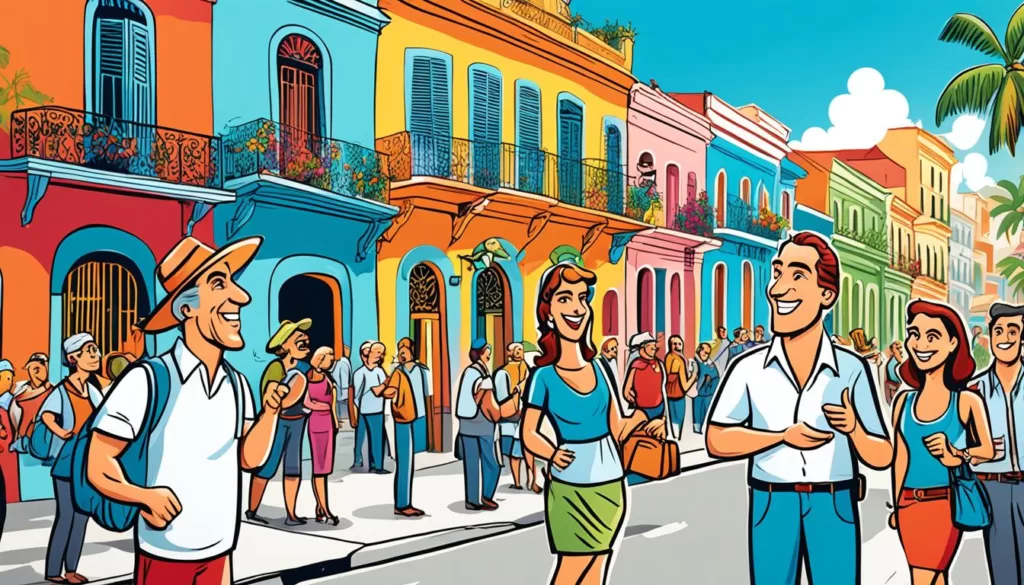
- Linguistic proficiency is a gateway to opportunities and cultural exchanges.
- English, French, Russian, and Chinese are shaping the future of Cuba’s international relations.
- The mastery of these languages is creating a cosmopolitan flair within Cuba’s already rich cultural fabric.
Cuba continues to dance to the timeless rhythm of inclusivity and diversity, with languages as its partners, artistic steps twirling towards a future where communication transcends borders and invites a world of possibilities.
Understanding Cuban Spanish: The Caribbean’s Distinct Flavor
The vibrant heart of the Caribbean, Cuba is not only famous for its enchanting music and warm, hospitable culture but also for the distinct flavor of its language. Cuban Spanish phonology diverges notably from its continental counterparts, an auditory testament to the island’s rich ethnic tapestry.

Interlacing the melodies of indigenous voices with a resonant African heart, the rhythms of Cuban Spanish reflect a powerful saga of historical voyages and cultural mingling. The language serves as a living relic of the island’s multifaceted narratives, a harmonious blend of sounds that ranges from the poetic to the colloquial.
Phonology and Intonation
At its core, the Cuban Spanish phonology is marked by its harmonious intonation and melodious cadences, making it one of the most distinctive dialects within the Spanish-speaking world. Its rhythm is punctuated by the unique characteristics of Caribbean Spanish, whose phonetic nuances capture the hearts of linguists and the imagination of those who bask in its sounds. Cuban Spanish’s soft, nasal accent is particularly emblematic, arising from an intricate coalescence of linguistic threads woven over centuries.
Lexical Contributions from Afrocuban Communities
The linguistic contributions of Afrocuban communities have been monumental in shaping the colloquial speech of Cuba. Afrocuban linguistic contributions have deeply influenced the island’s vernacular, mixing Yoruba and Congolese elements into a robust lexicon replete with African rhythm. This melding has resulted in a Cuban Spanish that dances to an Afrocuban beat, giving the language its distinctive syncopation and exuberance.
| Cuban Spanish Feature | African Influence | Example in Cuban Spanish |
|---|---|---|
| Phonetic Accommodation | Yoruba and Bantu Phonemes | Use of nasal vowels and consonants |
| Lexical Borrowing | Yoruba Lexicon | Words like “ashe” (power, authority) |
| Rhythmic Intonation | Afrocuban Music and Orature | Melodic speech patterns mirroring musical rhythms |
| Cultural Terms | Afrocuban Religious Concepts | “Santería” terms like “orisha” (deity) |
The aesthetic elegance of Cuban Spanish is both heard in the rolling rs and seen in the animated gestures accompanying daily conversations. Caribbean Spanish characteristics are not merely lingual; they are cultural emblems, facets of identity, and, above all, a source of pride among Cubans.
As the Cuban Spanish language continues to enchant with its melodic intonation and rhythmic fluency, it stands as a testament to the country’s ability to blend multifarious linguistic elements into a rich, cohesive linguistic patrimony. It is a language that invites you to feel its rhythm, to dive into its history, and to experience the warmth of its people.
Conclusion: Celebrating Cuba’s Linguistic Tapestry
The intricate weave of Cuba’s linguistic legacy paints a picture of the island as a cultural crossroads. Here, the vibrant echoes of Cuban Spanish in its myriad dialects merge with the reflective tones of creole languages in Cuba, including Haitian Creole, establishing a rich patois of sounds and meanings. Clearly, linguistic diversity in Cuba is not just a feature of its cultural fabric; it is the essence that defines its people’s resilience and adaptability to an ever-changing world.
From the sonorous impact of African orishas to the melodious contributions of European settlers, every corner of the island resonates with a history spoken through its tongues. This multilingual chorus is further amplified by the influence of modern languages thanks to the island’s burgeoning tourism sector and expanding international relations. The essence of Cuban language culture is palpable, serving as a bridge between antiquity and the future, creating an evolving narrative that continues to draw interest and intrigue across the globe.
In summary, Cuba’s language landscape is a testament to a story repeated in every ripple of its Caribbean waves and every shade of its lush, tropical landscapes. As Cuba embraces a new era, it continues to honor the linguistic heritage of its past while dynamically engaging with the global community, reinforcing its status as an eminent hub of linguistics and cultural interchange. The nation’s melodic cadences and vivid expressions invite the world to listen, learn, and celebrate the enduring spirit of Cuba and its people.
FAQ
What languages are spoken in Cuba?
The official language spoken in Cuba is Cuban Spanish. Besides Spanish, other languages such as Haitian Creole, various African languages, and European languages like Galician and Corsican are spoken by different ethnic communities. English and other foreign languages are also increasingly used, particularly in the tourism sector.
What is the official language of Cuba and how does the Cuban dialect differ from other Spanish dialects?
The official language of Cuba is Spanish, specifically Cuban Spanish, which has distinctive phonology, intonation, and expressions that set it apart from other Spanish dialects. The Cuban dialect includes unique slang and often incorporates elements from African and indigenous languages.
How has the Taíno language influenced Cuban Spanish?
The Taíno language has left its mark on Cuban Spanish through various words that have been incorporated into the modern vocabulary. These words reflect the linguistic legacy of Cuba’s original inhabitants and the island’s history before the Spanish colonization.
Are there unique Cuban slang and expressions?
Yes, Cuban Spanish is rich in slang and unique expressions known as ‘cubanismos.’ These terms often have origins in the island’s diverse cultural history and can differ significantly from mainstream Spanish, offering a glimpse into the local vernacular and cultural idiosyncrasies.
What are some indigenous languages of Cuba?
The indigenous languages of Cuba, primarily the Taíno language, are not spoken today but have influenced the vocabulary of Cuban Spanish. Elements of these languages remain in the cultural and linguistic heritage of the island.
How prevalent is Haitian Creole in Cuba?
Haitian Creole is the second most spoken language in Cuba, mainly among the Haitian immigrant population and their descendants. It is a significant part of the linguistic landscape due to the historical migration from Haiti.
What impact have African languages had on Cuban language and culture?
African languages have significantly influenced Cuban vernacular, particularly through the historical presence of African slaves. These influences are evident in the vocabulary, accent, and intonation of Cuban Spanish, especially within the context of the Afro-Cuban religion Santería, where the Lucumí language is used in religious practices.
Which European languages are spoken within Cuba?
In addition to Spanish, other European languages such as Galician and Corsican are spoken by some communities within Cuba, stemming from historical waves of European immigration to the island.
How widespread is the use of foreign languages like English and French in modern Cuba?
English is widely spoken in Cuba, especially in the tourism industry and urban areas. French, along with other foreign languages like German, Russian, and Chinese, is spoken among those engaged in international relations and the tourism sector, reflecting the island’s diverse global connections.
What are some key characteristics of Cuban Spanish phonology and intonation?
Cuban Spanish phonology is characterized by its distinct pronunciation of certain consonants and a softer, more nasal intonation compared to other Spanish dialects. This unique sound profile is a result of the island’s ethnic and cultural diversity.
How have lexical contributions from Afro-Cuban communities influenced Cuban Spanish?
Afro-Cuban communities have contributed numerous words to Cuban Spanish, including those derived from African languages. These contributions have added to the rhythmic and expressive nature of Cuban Spanish, enriching the language with cultural significance and diversity.

